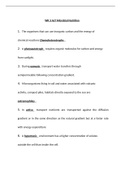Class notes
Victims and Offenders of Violence Lecture notes
- Course
- Institution
Lecture 1: Definition and types of violence, Lecture 2: Violence victimization: its meaning and prevalence, Lecture 3: Victim recognition in the Criminal Justice System, Lecture 4: Data visualization, Lecture 5: Research violence, Lecture 6: Exploring sexual violence victimhood in men, Lecture 7: G...
[Show more]




